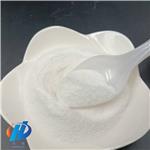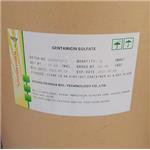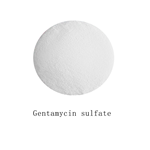- Gentamycin Sulfate
-

- $15.00/ kg
-
2024-04-25
- CAS:1405-41-0
- Min. Order: 1kg
- Purity: 99.912%
- Supply Ability: 10ton
- Gentamicin sulfate
-

- $0.00 / 10bou
-
2024-04-25
- CAS:1405-41-0
- Min. Order: 10bou
- Purity: ≥590IU/mg
- Supply Ability: 10000bou
- Gentamycin sulfate
-

- $0.00/ BOU
-
2024-04-16
- CAS:1405-41-0
- Min. Order: 10BOU
- Purity: 590IU/mg
- Supply Ability: 1000BOU
|
| | Gentamicin sulfate Basic information |
| | Gentamicin sulfate Chemical Properties |
| Melting point | 218-237°C | | alpha | D25 +102° | | density | 1.000 g/cm3 | | storage temp. | 2-8°C | | solubility | H2O: 50 mg/mL As stock solution, store at −20°C. Stable at 37°C for 5 days. | | form | powder | | color | colorless to light yellow | | PH | 4.0-5.5 (0.1g/mL in H2O) | | Odor | odorless | | optical activity | [α]20/D +110±8°, c = 1% in H2O | | Water Solubility | Soluble in water | | Merck | 13,4403 | | InChIKey | RDEIXVOBVLKYNT-HDZPSJEVSA-N | | CAS DataBase Reference | 1405-41-0(CAS DataBase Reference) | | EPA Substance Registry System | Gentamicin sulfate (1405-41-0) |
| Hazard Codes | Xn | | Risk Statements | 42/43 | | Safety Statements | 23-36/37-45-22-24/25 | | WGK Germany | 2 | | RTECS | LY2625000 | | F | 3 | | HS Code | 29419010 | | Toxicity | LD50 in mice (mg base/kg): 430 i.p.; 485 s.c.; 75 i.v.; >9050 orally (Black) |
| | Gentamicin sulfate Usage And Synthesis |
| Chemical Properties | White to buff-colored powder, hygroscopic, easily soluble in water, insoluble in lipids, insoluble in organic solvents, stable in chemical properties, relatively stable to changes in temperature and pH, the pH of 4% aqueous solution is 4.0-6.0. There are five basic centers in the gentamicin molecule, which is a basic compound, and the drug is the sulfate of gentamicin. Gentamicin is a complex of C components, the main components of which are C1, C2, C1a, and C2a. | | Originator | Garamycin,Schering,US,1966 | | Uses | This compound is a complex mixture of the sulfates of gentamycin Cl, gentamycin CIA and gentamycin C2. Pharmaceutical
incompatibilites include amphotericin, cephalosporins, erythromycin, heparin, penicillins, sodium bicarbonate, and sulfadiazine sodium. It is used as topical and systemic broad-spectrum antibiotic with bactericidal action; also used in ophthalmic drugs. | | Uses | Gentamicin sulfate is an aminoglycoside antibiotic. Inhibits protein synthesis by binding to L6 protein of 50S ribosomal subunit. Antibacterial. Antibiotic complex consists of three closely related components, gentamicins C1, C2, C1a, and also gentamicin A which differs from the other members of the complex but is similar to Kanamycin C. Gentamicin C1: R1=R2=CH3 Gentamicin C2: R1=CH3; R2=H Gentamicin C1A: R1=R2=H. | | Manufacturing Process | Germination Stage: A lyophilized culture of M. purpurea is added to a 300 ml
shake flask containing 100 ml of the following sterile medium: 3 grams bacto�beef extract; 5 grams tryptose; 1 gram dextrose; 24 grams starch (soluble);
5 grams yeast extract; and 1,000 ml tap water. The flask and its contents are
incubated for 5 days at 37°C on a rotary shaker (280 rpm, 2 inch stroke).
Inoculum Preparation Stage: Two batches of inoculum of about 50 gallons
each are prepared by the following method: A 25 ml inoculum (from the
germination stage) is transferred to each of four 2-liter flasks, each containing
500 ml of the sterile medium utilized for germination. The flasks and contents
are incubated for 5 days at 28°C on a rotary shaker (280 rpm, 2 inch stroke).
The contents of the flasks are pooled, a 25 ml inoculum (taken from the pool)
is added to each of twenty 2-liter flasks, each containing 500 ml of the
following sterile medium: 30 grams soybean meal; 40 grams dextrose
(cerelose); 1 gram calcium carbonate; 1,000 milliliters tap water. The flasks
and their contents are incubated for 3 to 5 days at 28°C on a rotary shaker
(280 rpm, 2 inch stroke). The broth is pooled and aseptically transferred into
a sterile inoculum flask having a side arm (total volume, about 10 liters).
The 10 liters of inoculum is aseptically transferred to a 65-gallon fermenter
containing 50 gallons of the following sterile medium: 600 grams bacto-beef
extract; 1,000 grams bacto-tryptose; 200 grams dextrose (cerelose); 4,800
grams starch (soluble); 1,000 grams yeast extract; 100 ml antifoamer GE 60
(General Electric Co. brand of silicone defoamer), or other defoamer; and tap
water, qs to 50 gallons.
The pH is adjusted to 6.9 to 7.0 before sterilization and aerobic fermentation
is effected for 24 hours (until the packed cell volume is about 10 to 15%) under the following conditions: temperature, 37°C; sterile air input, 54
ft3/min; pressure, 7 psi; and agitation, 180 rpm.
Fermentation Stage: One 50-gallon batch of inoculum is aseptically
transferred to a 675-gallon fermenter (fermenter A) containing the following
medium: 54.0 kg soybean meal; 72.0 kg cerelose; 9.0 kg calcium carbonate;
300 ml antifoamer GE 60; and 450 gallons soft water. The other 50-gallon
batch of inoculum is aseptically transferred to a similar fermenter (fermenter
B) containing the same medium as fermenter A with the addition of 200 mg of
CoCl2 · 6H2O. Fermentation is effected in each fermenter at 35°C while
agitating at 120 rpm with air input at 7 psi and 15 ft3/min. At various times,
samples of the fermented broth are withdrawn and assayed for antibiotic
production by the disc assay method. The following table shows the increase
in yield effected by the presence of cobalt, (as described in US Patent
3,136,704).
The conversion of the broth to gentamicin sulfate is described in US Patent
3,091,572. | | Brand name | Apogen (King); Garamycin (Schering); Genoptic (Allergan); Gentacidin (Novartis); Gentafair (Pharmafair); Gentak (Akorn); U-Gencin (Pharmacia & Upjohn). | | Therapeutic Function | Antibacterial | | General Description | Gentamicin sulfate is a sulfate salt of an antibiotic complex produced by fermentation of Micromonospora purpurea or M. echinospora. There are three components, each consisting of five basic nitrogens and requiresing five equivalents of sulfuric acid per mole of gentamicin base. Three closely related components that are chemically amino-saccharides. White to buff-colored powder. pH (4% solution) 3.5 to 5.5. Odorless. | | Air & Water Reactions | Water soluble. Hygroscopic. | | Reactivity Profile | Gentamycin sulfate is very stable in solution, even in moderately acidic to strongly basic aqueous media. | | Fire Hazard | Flash point data for Gentamycin sulfate are not available; however, Gentamycin sulfate is probably combustible. | | Biochem/physiol Actions | Mode of Action: Gentamicin inhibits protein synthesis by binding to the 30S subunit of the ribosome.Antimicrobial spectrum: Includes Gram-negative and Gram-positive bacteria, including strains resistant to tetracycline, chloramphenicol, kanamycin and colistin, particularly strains of Pseudomonas, Proteus, Staphylococcus and Streptococcus. | | Safety Profile | Poison by intravenous,
intraperitoneal, and intramuscular routes.
Moderately toxic by subcutaneous route.
Human systemic effects: level changes for
metals other than Na/K/Fe/Ca/P/Cl. An
experimental teratogen. Other experimental
reproductive effects. Mutation data
reported. When heated to decomposition it
emits very toxic fumes of SOx. See also
other gentamycin entries. | | storage | Store at +4°C | | References | Schroeder et al (2000) Modulation of RNA function by aminoglycoside antibiotics. EMBO.J. 4 1. PMID: 10619838.
Casemore (1967) Gentamicin as a bactericidal agent in virological tissue cultures. J.Clin.Pathol. 20 298. PMID: 4972293
Martin, N.L., et al. Gentamicin interaction with Pseudomonas aeruginosa cell envelope. J. Comp. Neurol. 1986, 29(6), 1079-1087. DOI:10.1128/AAC.29.6.1079
Kadurugamuwa, J.L., et al. Surface action of gentamicin on Pseudomonas aeruginosa. J. Bacteriol. 1993, 175(18), 5798-805. DOI:10.1128/jb.175.18.5798-5805.1993 |
| | Gentamicin sulfate Preparation Products And Raw materials |
|